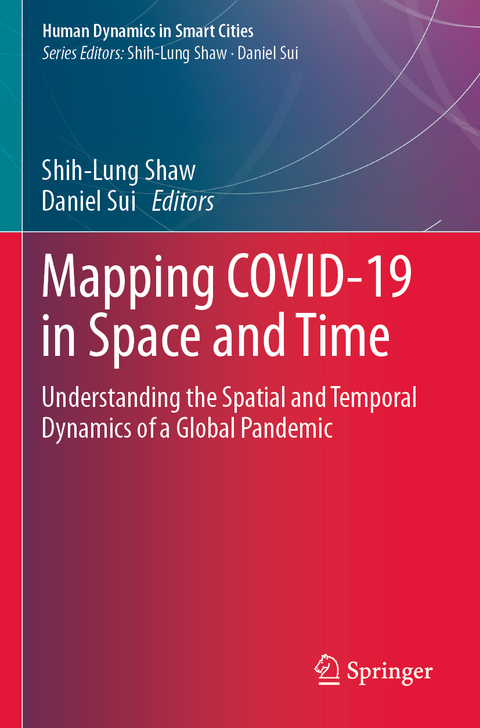
Mapping COVID-19 in Space and Time
Springer International Publishing (Verlag)
978-3-030-72810-6 (ISBN)
This book describes the spatial and temporal perspectives on COVID-19 and its impacts and deepens our understanding of human dynamics during and after the global pandemic. It critically examines the role smart city technologies play in shaping our lives in the years to come. The book covers a wide-range of issues related to conceptual, theoretical and data issues, analysis and modeling, and applications and policy implications such as socio-ecological perspectives, geospatial data ethics, mobility and migration during COVID-19, population health resilience and much more.
With accelerated pace of technological advances and growing divide on political and policy options, a better understanding of disruptive global events such as COVID-19 with spatial and temporal perspectives is an imperative and will make the ultimate difference in public health and economic decision making. Through in-depth analyses of concepts, data, methods, and policies, this book stimulates future studieson global pandemics and their impacts on society at different levels.Shih-Lung Shaw holds Chancellor's Professorship, Alvin and Sally Beaman Professorship, and Arts and Sciences Excellence Professorship at the University of Tennessee, Knoxville, USA. He served as the Department Head from 2007 to 2010 and Interim Associate Provost for International Education in 2017-2018. Dr. Shaw is an elected Fellow of the American Association for Advancement of Science (AAAS) and a recipient of the Edward L. Ullman Award for outstanding contributions to the field of transportation geography and the Outstanding Scholar Award in Regional Development and Planning from the Association of American Geographers (AAG).
Daniel Sui is Vice President for Research and Innovation at Virginia Tech, Blacksburg, USA, and Professor of Geography and Public & International Affairs. Prior to Virginia Tech, Dr. Sui was vice chancellor for research and innovation and a distinguished professor at the University of Arkansas, Fayetteville (2018-2020). Dr. Sui also served as Division Director for Social & Economic Sciences at the U.S. National Science Foundation (NSF) between 2016 and 2018. He was an Arts and Sciences Distinguished Professor at the Ohio State University (OSU) between 2009 and 2018. Dr. Sui was a 2009 Guggenheim Fellow and recipient of both AAG and CPGIS distinguished scholar award.
Preface: Michael Goodchild.- Chapter 1: Understanding the spatial and temporal dynamics of a global pandemic: Shih-Lung Shaw, Daniel Sui.- Section 1: Conceptual and Theoretical Perspectives: Chapter 2: A Power-Law-Based Approach to Mapping COVID-19 Cases in the United States: Bin Jiang and Chris de Rijke.- Chapter 3: Individual, context, and space: Using spatial approaches for understanding unequal social and psychological fallout of COVID-19: Grant Drawve, Casey Harris, and Kevin Fitzpatrick.- Chapter 4: An encrypted monument in the COVID-19 pandemic: A case study of crypto place on the blockchain: Xu Huang and Bo Zhao.- Chapter 5: Emotional responses through COVID-19 in Singapore: Yingwei Yan, Wei Chien Benny Chin, Chan-Hoong Leong, Yi-Chen Wang, and Chen-Chieh Feng.- Chapter 6: A socio-ecological perspective on COVID-19 spatiotemporal integrated vulnerability in Singapore: Chan-Hoong Leong, Benny Wei-Chien Chin, Yi-Chen Wang, and Chen-Chieh Feng.- Section 2: Data Perspectives: Chapter 7: Assessing connections and tradeoffs between geospatial data ethics, privacy, and the effectiveness of digital contact tracing technologies: Peter Kedron and Andrew B. Trgovac.- Chapter 8: Challenges and limitations of geospatial data in the context of COVID-19: Sean G. Young; Jyotishka Datta; Bandana Kar; Xiao Huang; Malcolm D. Williamson; Jason A. Tullis; and Jackson Cothren.- Chapter 9: Multi-level inter-regional migrant population estimation using multi-source spatiotemporal big data: A case study of migrants in Hubei Province during the outbreak of COVID-19 in Wuhan: Qian Jiale, Liu Zhang, Du Yunyan, Wang Nan, Yi Jiawei, Sun Yeran, Ma Ting, Pei Tao and Zhou Chenghu.- Section 3: Analysis and Modeling Perspectives: Chapter 10: Identifying and characterising active travel corridors for London in response to Covid-19 using shortest path and Streetspace analysis: Nicolas Palominos, Duncan A Smith, and Sam Griffiths.- Chapter 11: Multi-scale CyberGIS analytics for detecting spatiotemporal patterns of COVID-19: Fangzheng Lyu, Jeon-Young Kang, Shaohua Wang, Su Yeon Han, and Shaowen Wang.-Chapter 12: Dynamic spreading of COVID-19 vs community mobility in regions of England: Tao Cheng, Xinchen Zhong, Yang Zhang, and Guanshen Dong.- Chapter 13: Exploring store visit changes during the COVID-19 pandemic using mobile phone location data: Yunlei Liang, Kyle W. McNair, Song Gao, and Asligul Gocmen.- Section 4: Application and Policy Perspectives: Chapter 14: Citizen mobility and the growth of infections during the COVID-19 pandemic with the effects of government restrictions in Western Europe: Mohd Sarim, Qunshan Zhao, and Nick Bailey.- Chapter 15: A mathematical model for evaluating the medical resource availability of COVID-19 in time and space: Fei-Ying Kuo and Tzai-Hung Wen.- Chapter 16: Health resilience against pandemic crisis among European countries: Yijing Li.- Chapter 17: Improving public transportation safety in COVID-19 era through crowdsourcingtechnique: Qisheng Pan, Zhonghua Jin, and Tao Tao.- Chapter 18: Outlook and next steps: Understanding human dynamics in a post-pandemic world - Beyond mapping COVID-19 in space and time: Daniel Sui and Shih-Lung Shaw.
| Erscheinungsdatum | 17.07.2022 |
|---|---|
| Reihe/Serie | Human Dynamics in Smart Cities |
| Zusatzinfo | XI, 358 p. 118 illus., 106 illus. in color. |
| Verlagsort | Cham |
| Sprache | englisch |
| Maße | 155 x 235 mm |
| Gewicht | 522 g |
| Themenwelt | Studium ► Querschnittsbereiche ► Prävention / Gesundheitsförderung |
| Naturwissenschaften ► Geowissenschaften ► Geografie / Kartografie | |
| Schlagworte | Crypo place and pandemics • CyberGIS and pandemics • Digital Contact Tracing • Geography and COVID-19 • Geography and public health • Geospatial data ethics and privacy • GIS and pandemics • Global pandemics and smart cities • Health resilience during pandemics • Medical Geography • Mental health during COVID-19 • Mobility and travel behaviour • Smart city technologies during COVID-19 • spatial data analysis |
| ISBN-10 | 3-030-72810-2 / 3030728102 |
| ISBN-13 | 978-3-030-72810-6 / 9783030728106 |
| Zustand | Neuware |
| Haben Sie eine Frage zum Produkt? |
aus dem Bereich


